Vinews
No. 12 — June 10, 2019
Contents:
- Norton and Mancozeb Phytotoxicity
- Cumulative Growing Degree Days for the Seven Grape Growing Regions of Missouri from April 1 to June 10, 2019
Norton and Mancozeb Phytotoxicity
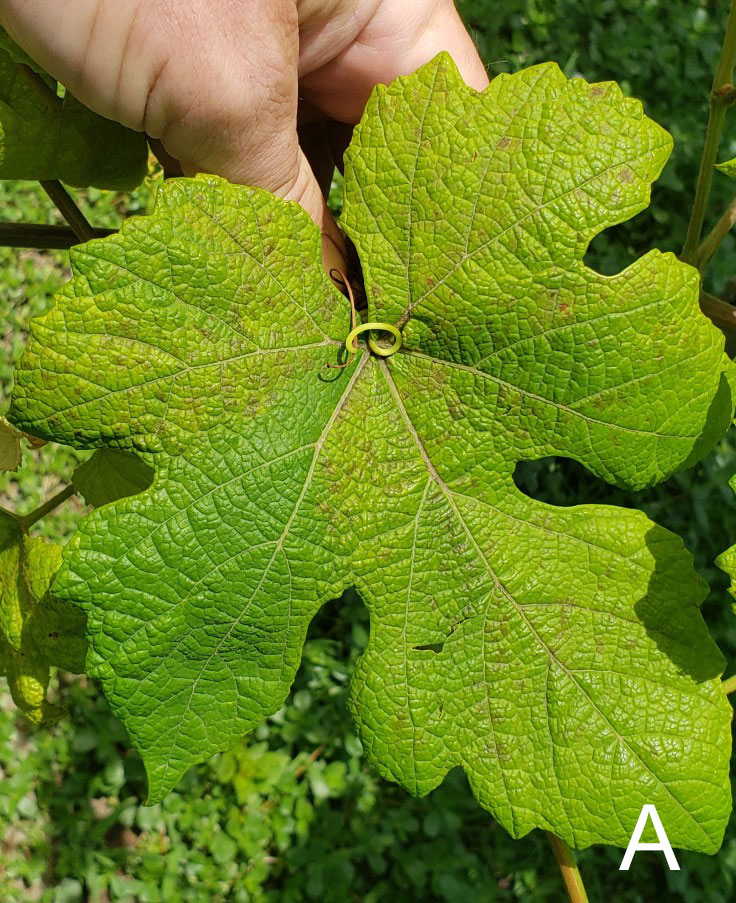
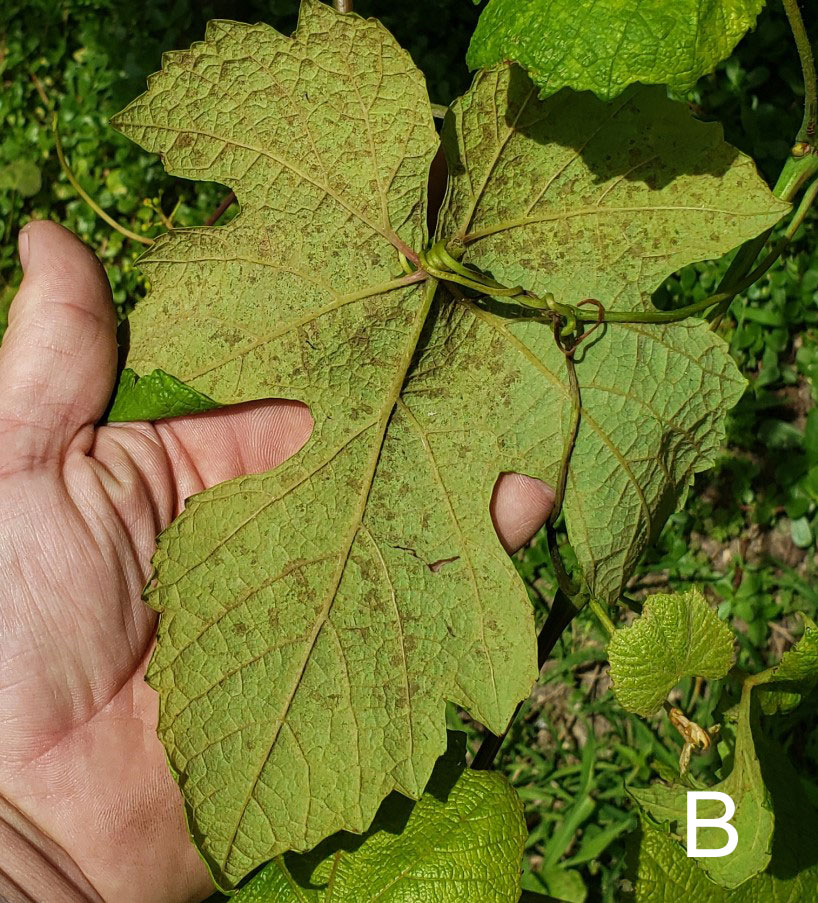
Last week I reported that grape growers in Virginia reported observing phytotoxicity from mancozeb on Norton leaves in 2018 and this was followed by a report from a grower in Missouri in June 2019. A Missouri grape grower reached out to me this week and shared some pictures of mancozeb phytotoxcity symptomology on Norton (Figure 1 and 2). As reported last week the symptomology observed in Virginia Norton leaves is very similar to what was observed in Missouri on Norton leaves after being treated with mancozeb. The underside of the Norton leaves turn tan or light brown and over time the leaves become necrotic. Eventually after 4 to 5 weeks the older basal leaves drop from the grapevines (Figure 3).
There has been a lot of speculation on what is causing the phytotoxicity after applying mancozeb to Norton grapevines. Initially since many growers in Virginia also grow V. vinifera cultivars and apply sulfur for disease control, speculation focused on spray tank contamination and/or potentially sulfur spray drift. Fortunately, I have some pictures of the symptomology on Norton sprayed with mixture of mancozeb and sulfur (Figure 4). A small amount of sulfur results in some very necrotic leaves. The phytotoxicity from the sulfur mancozeb tank mix appears to be much more extreme than mancozeb alone.
Additional thoughts on why phytotoxicity was occurring on Norton after a mancozeb application centered on adjuvant additions to the spray mixture. In 2018, a grower in Virginia applied mancozeb with a sticker to two rows of Norton and the leaves showed the classic browning compared to untreated rows. Unfortunately, there were no controls or mancozeb alone and sticker alone. In Missouri, in 2019, the damage to Norton occurred from mancozeb that was purchased in 2019. Whereas, the same mancozeb product purchased in a prior season did not cause phytotoxicity.
From all these observations, I turned to the literature to see if there were any plausible explanations.
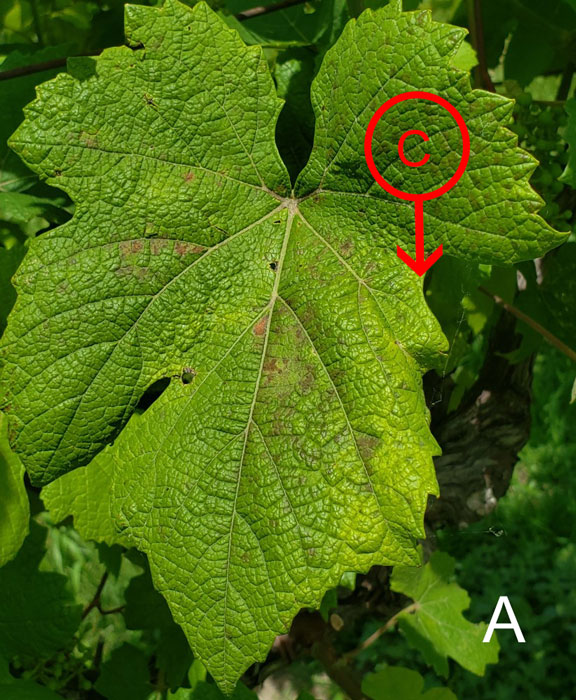
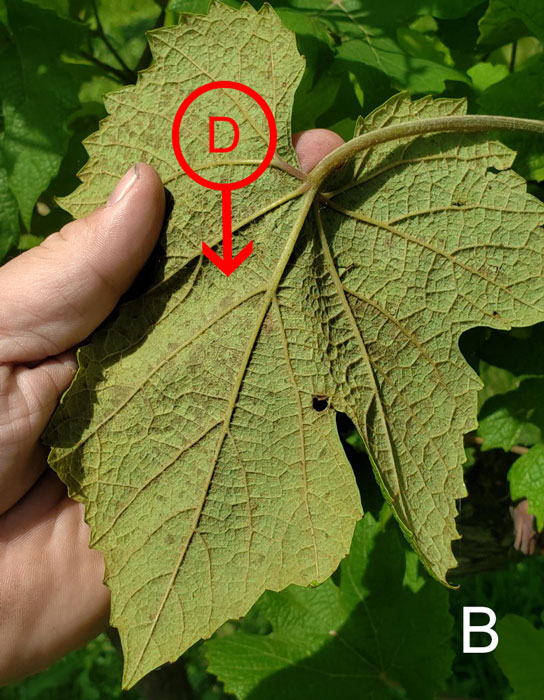
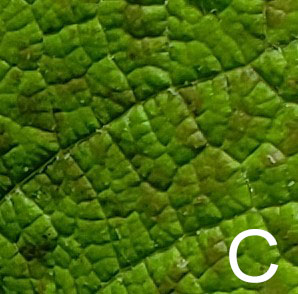

Mancozeb can be described as ethylenebisdithiocarbamate of manganese and zinc and is classified in the group of ethylenebisdithiocarbamate fungicides (EBDTC). Briefly, a bit of history of mancozeb. Dupont was responsible for the development of manganese ethylene bisdithiocarbamate (maneb) around 1950. Then around 1962, Rohm and Haas developed the zinc ion complex of maneb (mancozeb). Dow AgroSciences purchased Rohm and Haas in 2001 and is the current leading registrant of mancozeb products. Mancozeb is one of the leading fungicides used throughout the world based on sales.

In grape production mancozeb is widely used to control a number of common diseases including black rot, downy mildew, phomopsis, anthracnose and others. The mode of action of mancozeb is varied and no microorganisms to date have evolved resistance to mancozeb. Since mancozeb has a 66-day pre-harvest interval (PHI) the product is withdrawn from most spray programs around the time of bloom.
The chemical breakdown of mancozeb results in a number of different degradation products. Ethylenethiourea (ETU) is the end product of mancozeb degradation and can be used as a biomarker for plants or humans exposed EBDTC fungicides. ETU forms in the presence of water and oxygen. Also in the commercial production of EBDTC fungicides, ETU is a trace contaminant. Storage of mancozeb can also result in the conversion to increased amounts of ETU. There are a substantial number of papers published demonstrating that the percentage of mancozeb declines in storage over time. Mancozeb degradation is hastened in opened containers versus unopened packages.
Mancozeb itself has no fungicidal properties but upon exposure to water mancozeb breaks down to release ethylene bisisothiocynate sulfide (EBIS). The exposure of EBIS to UV light produces ethylene bisisothiocyanate (EBI). Both EBIS and EBI are purported to be the active ingredients controlling a wide range of microorganisms.
There are very limited reports of mancozeb phytotoxicity to crop plants. However that does not mean that phytotoxcity will never result from applying mancozeb to Norton. From the literature there is ample evidence showing that a number of vegetables after being treated with mancozeb will produce the following metabolites: elemental sulfur, EBIS, ETU, ethylenediamine and others. Norton is sulfur sensitive. The question becomes what are the metabolites in Vitis spp. treated with mancozeb. There is good evidence that ETU is formed during grape production from vines treated with mancozeb as wines made from these grapes contain the stable ETU metabolite.
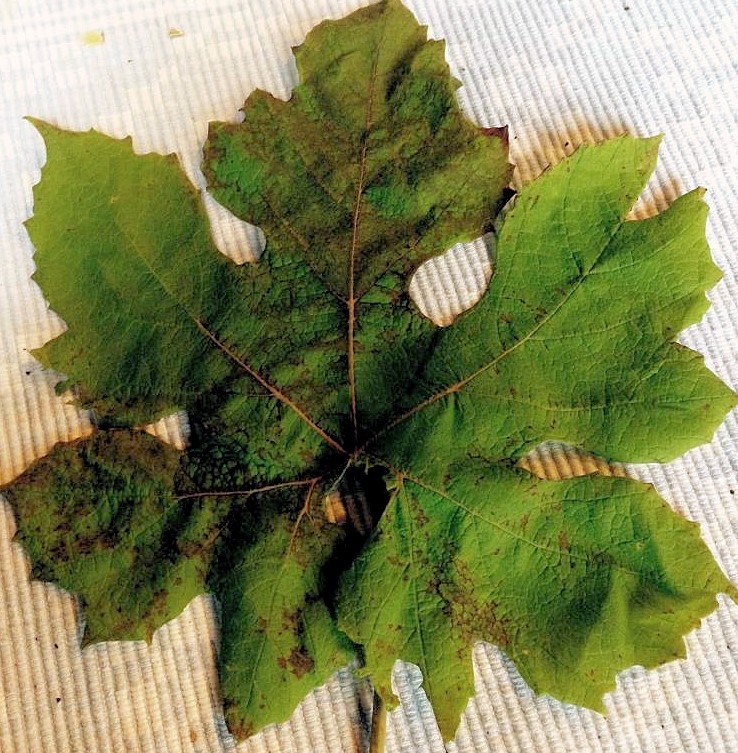
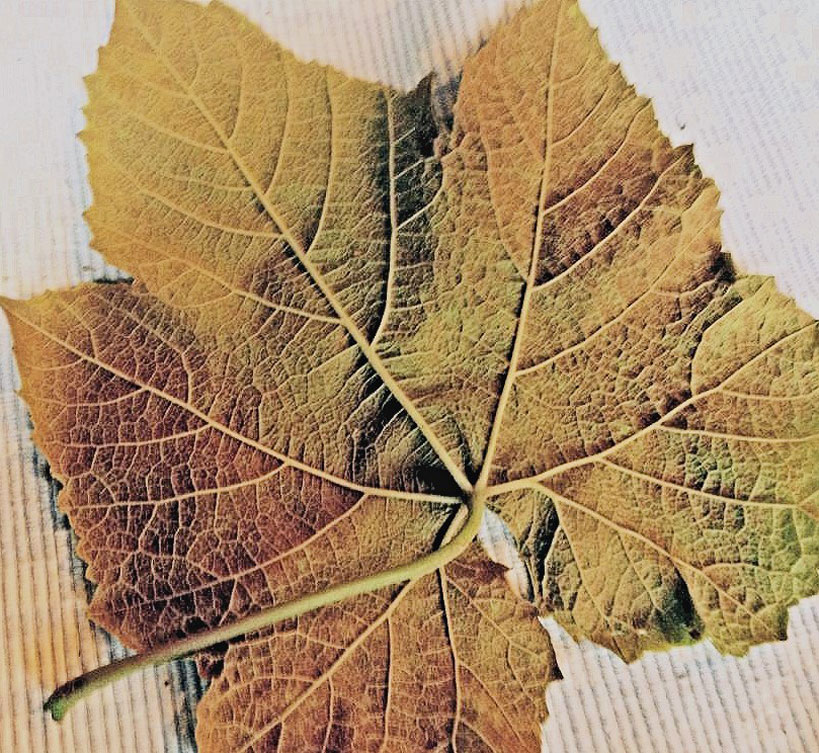
On the other hand, there is anecdotal evidence that improperly stored mancozeb could also be playing a role in the phytotoxcity in Norton. Improper storage of mancozeb could result in degradation products that are bioactive. The Dithane M45 label clearly specifies the pesticide storage conditions. “Store in cool, dry, well ventilated area. Do not allow to become wet or overheated in storage: decomposition, impaired activity, or fire may result. Keep the container closed when not in use”. There are very good reasons why the label states all these storage conditions for mancozeb. Opened containers of mancozeb will degrade to form degradation products.
So the take-home message from all this is the following:
- Mancozeb is causing phytotoxicity to Norton grapevine leaves. At this time it is unknown what chemical degradation product of mancozeb is causing the damage. Potential candidates would be elemental sulfur, ethylene bisisothiocynate sulfide (EBIS) and ethylene bisisothiocyanate (EBI)
- Mancozeb breaks down over time in the presence of heat and oxygen exposure. Some of these degradation products are bioactive and inhibit pathogen infection. These degradation products are likely also implicated in causing phytotoxicity in Norton leaves.
- Mancozeb should be stored in cool locations and opened containers should be resealed to reduce exposure to oxygen. Oxygen exposure results in the formation of mancozeb degradation products that are bioactive
References
- Environmental Fate of Mancozeb
- Ethylenebisdithiocarbamtes and Ethylenethiourea: Possible Human Health Hazards
- Ethlenethiourea in Urine as an Indicator of Exposure to Mancozeb in Vineyard Workers
- Mancozeb Past, Present, and Future
- Metabolic Fate of Mancozeb in Tomato (Lycopersicon Esculentum)
- Radiotracer Studies of Fungicide Residues in Food Plants
Cumulative Growing Degree Days for the Seven Grape Growing Regions of Missouri from April 1 to June 10, 2019
| Region | Location by County | Growing Degree Days1 | ||
|---|---|---|---|---|
| 2019 | 2018 | 30-year Average | ||
| Augusta | St. Charles | 982 | 1083 | 944 |
| Hermann | Gasconade | 964 | 1043 | 906 |
| Ozark Highland | Phelps | 1047 | 1147 | 990 |
| Ozark Mountain | Lawrence | 1031 | 1121 | 969 |
| Southeast | Ste. Genevieve | 1014 | 1078 | 981 |
| Central |
Boone | 962 | 1098 | 909 |
| Western | Ray | 871 | 1023 | 876 |
1 Growing degree days at base 50 from April 1 to June 10, 2019. Data compiled from Useful and Useable at https://mygeohub.org/groups/u2u/tools. Click on link below to determine growing degree days in your area.
To determine the number of growing degree days accumulated in your area since April 1, use this tool.